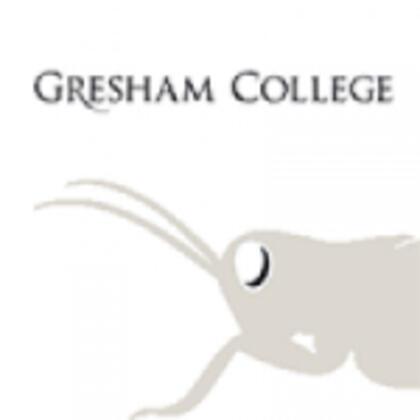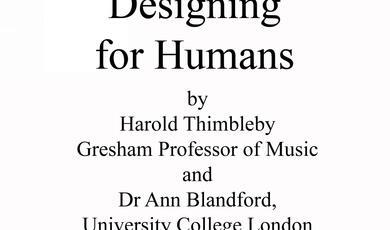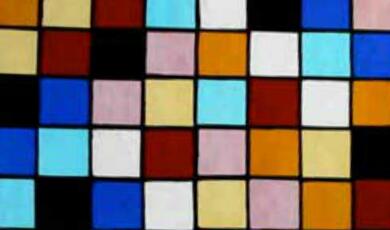The Geometry of Music
Share
- Details
- Transcript
- Audio
- Downloads
- Extra Reading
Geometers study shapes and how they transform into one other. Musicians create shapes and transform them. We illustrate with some examples that are interesting to both geometers and musicians.
Download Transcript
The Geometry of Music
Professor Wilfrid Hodges
1. Music takes place in a two-dimensional space, where the dimensions are time and pitch.
Usually we write time from left to right, and higher pitch is higher on the page. (So time is on
the x axis and pitch on the y axis.) Conventional western music uses only certain pitches and
rhythms.
Edward Elgar, 'Enigma Variations: xi, GRS', EMI 1983.
George Gershwin, 'Rhapsody in Blue', with Paul Whiteman, Gemm 1991.
Fairuz, 'Ya mersal el marassil', Chahine 1993.
2. Since the time of Felix Klein (1849-1925), geometers have classified spaces and their
contents by applying transformations and seeing what stays fixes and what moves. We
multiply transformations S and T by doing S first and then T; we invert T by doing T
backwards. A transformation group consists of a nonempty set of transformations of a space,
closed under multiplication and inverse. For musical space one of the most important groups
is the Klein Four-group with multiplication table
3. The transformation Mh moves points in time, as if they were reflected in a mirror placed
vertically. Applying Mh to a piece of music runs it backwards in time. Some pieces are the
same forwards as backwards, so Mh leaves them unchanged; we say Mh is a symmetry of
these pieces.
Georg Handel, 'Messiah: Hallelujah Chorus', Naxos 1992.
4. The transformation Mv turns pitches upside down, as if in a mirror laid horizontally. It's
not always obvious when one piece is the same as another but upside down.
Nicol`o Paganini, 'Capriccio 24 for Violin', DG 1978.
Sergei Rachmaninov, 'Rhapsody on a theme of Paganini: Variation 18', Vox Box 1991.
5. Rotation R turns a thing around by 180 degrees, so that it's upside down and faces
backwards. Multiplying transformations, R equals Mh ×Mv. Rimsky-Korsakov uses a theme
with symmetry R (but not Mh or Mv) for a signal that can be sent two ways.
Nikolai Rimsky-Korsakov, 'The golden cockerel', DCA 1991.
6. Pieces whose group of symmetries is the entire Klein Four-group are very hard to find. It
seems most composers avoid them.
John Tavener, 'The Lamb', Naxos 2000.
7. The only other groups that transform a musical theme within a bounded area of musical
space involve rotations through other angles, and these don't seem to be musically
significant. So to go beyond the Klein Four-group we need transformations of infinite order;
these generate groups that take a theme arbitrarily far away from its original position. The
simplest example is a translation Th moving everything through a fixed distance in time.
Doing Th once gives a repeat.
8. Doing Th once and then twice gives the same theme three times in a row. Like '• • • ', this
suggests an infinite repetition, or something that sounds over and over again like a church
bell.
Benjamin Britten, 'Peter Grimes'.
Arvo P¨art, 'Cantus in memoriam Benjamin Britten', EMI Classics for Pleasure 2002.
9. Multiplying Th by Mv gives an upside down repetition (called a glide reflection).
Judith Weir, 'King Harald's Saga'.
10. Horizontal dilation Dh stretches the time in some fixed ratio r. (If r > 1 it slows down the
music, if 0 < r < 1 it speeds it up.) An example of Dh combined with a translation is at a high
point of Brahms' Requiem, where he chose his own words 'You are sad now, but I will see
you again; I will comfort you', apparently in memory of his mother. The theme on 'I will see
you again' is repeated lower and slower, as if by Brahms himself responding to his mother.
Johannes Brahms, 'Ein Deutsches Requiem: Ihr habt nun Traurichkeit', EMI Classics 1993.
11. Multiple applications of Dh together with translations generate two striking pieces of
music. Nancarrow takes the ratio very close to 1, so the themes get closer towards the middle
of the piece, raising the tension continuously, and then drift apart. Finer makes the separate
voices repeat too, and fixes the ratios so that the voices come into alignment exactly once
every thousand years.
Conlon Nancarrow, 'Studies for Player Piano 36', Wergo 1990.
Jem Finer, http://longplayer.org
12. We started by classifying the musical themes within a given framework of pitches and
rhythms (a subspace of the full musical space). By the end we were classifying the
frameworks too. Since around 1900, many western composers have built their own
frameworks instead of accepting one given by the style of the time. As an example of
choosing a framework, I give two new scales that contain exactly the same intervals the same
number of times, but are not either the same scale or inversions of each other. (This last is
work in progress, joint with Patrick Ozzard-Low.)
J. Fauvel. R. Flood and R. Wilson eds., Music and Mathematics: From Pythagoras to
Fractals, Oxford University Press 2003.
L. Harkleroad, The Math behind the Music, Cambridge University Press 2006.
D. Lewin, Generalized Musical Intervals and Transformations, Oxford University Press
2007. (For the serious scholar. Full of musical insights, but I think it makes the mathematics needlessly heavy.)
©Wilfrid Hodges, 30 November 2009
Part of:
This event was on Mon, 30 Nov 2009
Support Gresham
Gresham College has offered an outstanding education to the public free of charge for over 400 years. Today, Gresham plays an important role in fostering a love of learning and a greater understanding of ourselves and the world around us. Your donation will help to widen our reach and to broaden our audience, allowing more people to benefit from a high-quality education from some of the brightest minds.


 Login
Login






